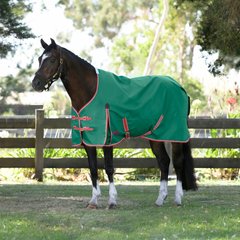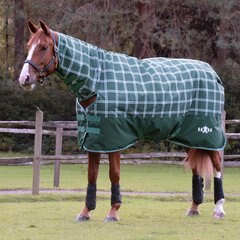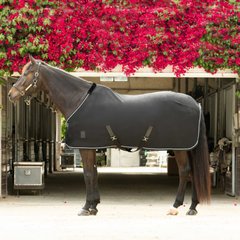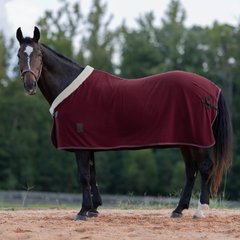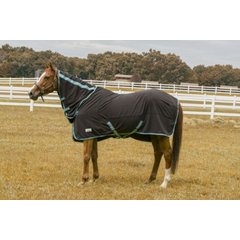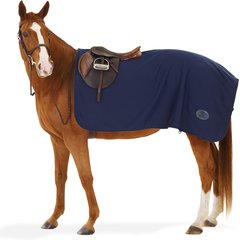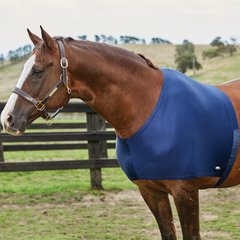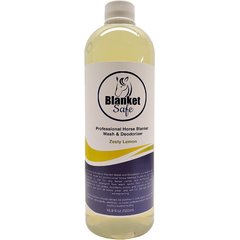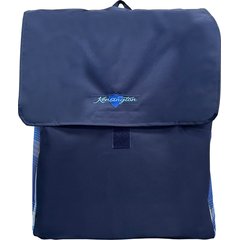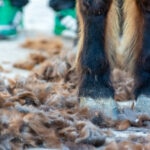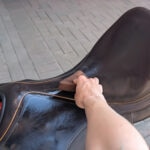Horse Blanket Guide: How To Choose the Best Horse Blankets
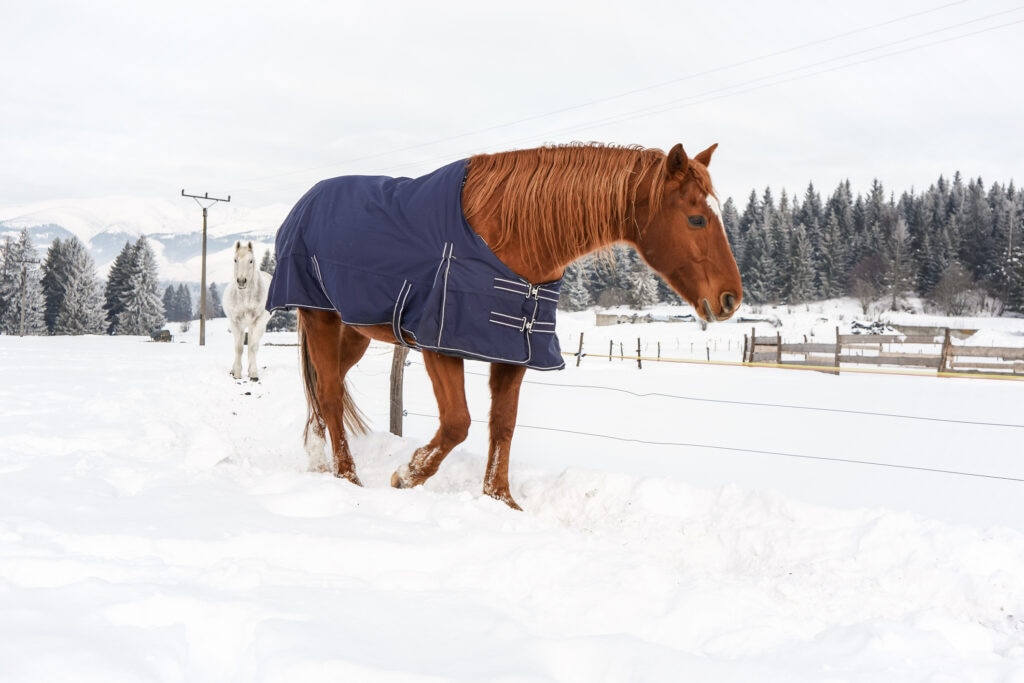
Photo by Lubo Ivankowarm/iStock / Getty Images Plus
With shorter days, dropping temperatures, and wet weather on the way, it’s time to think about which horse blankets your horse may need this season.
Healthy horses with a shelter may not need a blanket, while older horses, clipped show horses, or those in regular work need extra protection.
Key Takeaways
- Choosing the right blanket depends on climate, shelter, coat thickness, age, and workload.
- Investing in quality and cleaning, repairing, and waterproofing a blanket extends its life.
- Proper fit is essential. Horse blankets that are too big or too small can cause rubs, shifting, or safety hazards.
Types of Horse Blankets
Horse blankets come in many styles, and knowing the differences will help you select the best style for your horse.
Turnout Blankets
Horse turnout blankets are waterproof, durable, and designed for outdoor use.
Recommended Products
“Durability is the biggest thing I tell clients to look for, because all the horses get turned out together,” says Stacy Anatriello, who runs a boarding barn in Schaghticoke, New York.
Anatriello recommends at least a 1200-denier blanket for protection against rolling and playing. For fill weight, she prefers midweight or lightweight with liners. That way horses don’t overheat if the temperature fluctuates, and this reduces the need for frequent blanket changing.
Stable Blankets
Stable blankets are warm but not waterproof, making them best for stalled horses. They’re popular for clipped or show horses kept under lights to maintain a sleek coat. Like turnouts, they come in light, medium, and heavy weights depending on the horse’s needs.
Coolers and Sheets
Even though the temperatures may be chilly, horses who stay in work throughout winter can work up a sweat. Coolers wick away moisture during cooldowns to keep them from getting chilled.
Coolers are made of moisture-wicking fabric, fleece, or wool blends and are available in a variety of styles, including full-body, blanket-sized, and quarter sheets.
Recommended Products
Some riders, like Anatriello, prefer blanket-sized fleece coolers with straps to help them stay secure. Others, like trainer Anna Tejero of Tejero Training at Checkmate Equestrian Center in Egg Harbor, New Jersey, keep both a regular fit and a full-body option with neck coverage on hand—especially for unclipped or very sweaty horses.
“Even though it may be cold out, it’s always 10–15 degrees warmer in the trailer during the winter from their body heat,” Tejero says. So after a show, she’ll use a cooler for the ride home to help absorb sweat and keep them comfortable.
Key Horse Blanket Features To Consider
Blankets include a wide variety of features, so it’s important to look beyond just the color and price tag. Also consider the following features:
- Material and durability: Stable blankets often use nylon or polyester, while turnouts feature ballistic nylon or ripstop polyester. Denier ratings (600D–1200D+) indicate durability.
- Insulation/fill weight: Blanket weights range from no fill to 100 grams (light), 200 grams (medium), and 300 grams (heavy).
- Waterproofing and breathability: Look for blankets that combine waterproof coatings to repel rain and snow with wicking fabrics to avoid skin irritations or overheating.
- Fit and sizing: Proper fit and sizing help avoid rubs and safety concerns. See fitting instructions below for a step-by-step guide on how to measure a horse for a blanket.
- Closures and adjustability: Options include closed-front, buckles, or snap closures; bellybands or surcingle straps keep blankets in place.
- Extras: Neck hoods (attached or detachable) and tail flaps add coverage in harsh weather.
Benefits of Using Horse Blankets
Not every horse needs a blanket, but for some, they offer key advantages. Here are the main benefits:
- Provide warmth and protection for light winter coats, for senior horses, and for those with health conditions such as Cushing’s disease or thin body condition.
- Shield against wind, rain, and snow when outdoors.
- Help hard keepers conserve energy and maintain weight during colder months.
- Regulate body temperature for clipped horses when stabled indoors.
- Manage winter coat growth in horses who stay in work.
- Keep muscles warm after exercise with coolers.
- Reduce mud and manure stains, especially in horses who love to roll, making grooming easier and saving time at the barn on cold days.
How To Choose the Right Blanket for Your Horse
Selecting the right blanket comes down to matching your horse’s needs with your environment.
- Climate and shelter: Evaluate your horse’s living conditions and the climate you live in. Horses are naturally built for cooler temperatures and bundling up may not be necessary, even one on 24/7 turnout.
- Age, coat, and workload: Seniors, clipped show horses, or thin-coated breeds like Thoroughbreds often need more warmth, while hardy horses with natural heavy coats may require none.
- Budget and brand: Quality blankets are investments and buying those made with quality materials pay off in fewer replacements.
- Trial and adjustment: No blanket fits every horse perfectly. Owners should watch for rubs, shifting, or discomfort, and adjust as needed. Blanket liners and shoulder guards, like the WeatherBeeta Stretch Shoulder Guard, can provide an extra layer of warmth and help protect against rubs without adding extra bulk.
Recommended Product
“I look for blankets that have a guarantee,” says Tejero. “These blankets aren’t the cheapest, but also not the most expensive, and knowing [the manufacturer] will replace the blanket if it rips or is no longer waterproof within the stated time frame is worth it.”
How To Size a Horse Blanket
Horse blanket sizes are measured in inches or centimeters, indicating the length from the center of the horse’s chest to their hindquarters. Following these steps will help you decide how to size a horse blanket.
- Stand your horse squarely on level ground.
- Place a measuring tape at the center of the chest and run it along the side to the middle of the tail.
- Record the measurement in inches—this is your blanket size.
Fit may vary by brand, so check reviews and avoid oversizing. “Blankets that are too big can easily turn or slide off a horse, especially one on turnout,” Anatriello cautions.
Caring for Horse Blankets
When cared for properly, blankets should last more than one season. These tips can help you prolong their wearability:
- Spray turnout blankets with a waterproofer before winter.
- Wash blankets with a detergent-free, animal-safe wash, like Blanket Safe Wash & Deodorizer Zesty Lemon Scent Wash.
Recommended Product
- Repair moderate rips and tears and replace stretched or broken leg straps.
- Replace blankets when they show wear and tear that poses a safety hazard or no longer provides the intended protection.
- After winter is over, wash, dry thoroughly, and store in totes or blanket storage bags, like this one by Kensington.
Recommended Product
Horse blankets play a role in keeping horses healthy and comfortable, while saving you time on grooming. However, they aren’t a one-size-fits-all solution. Before investing in blankets, consider your horse’s age, overall condition, living arrangements, and workload to determine the best fit for your situation.
